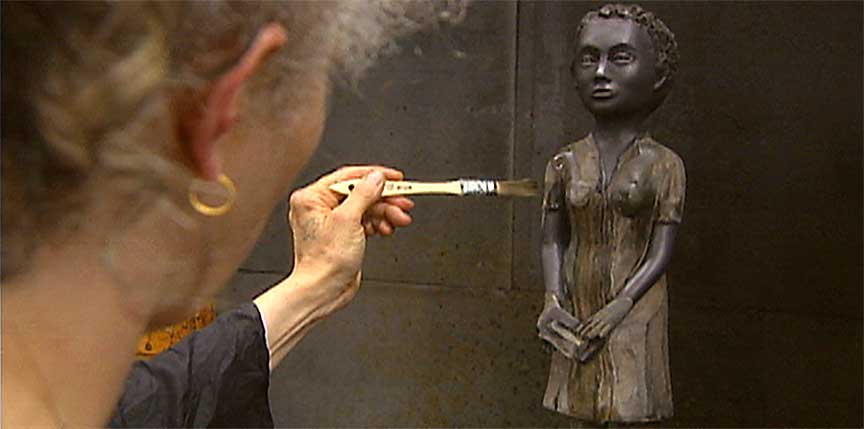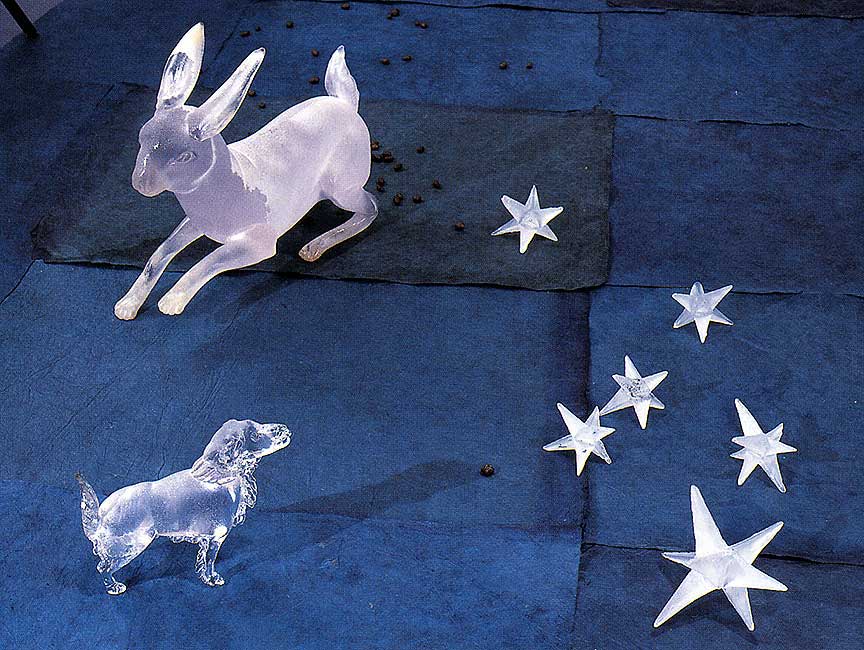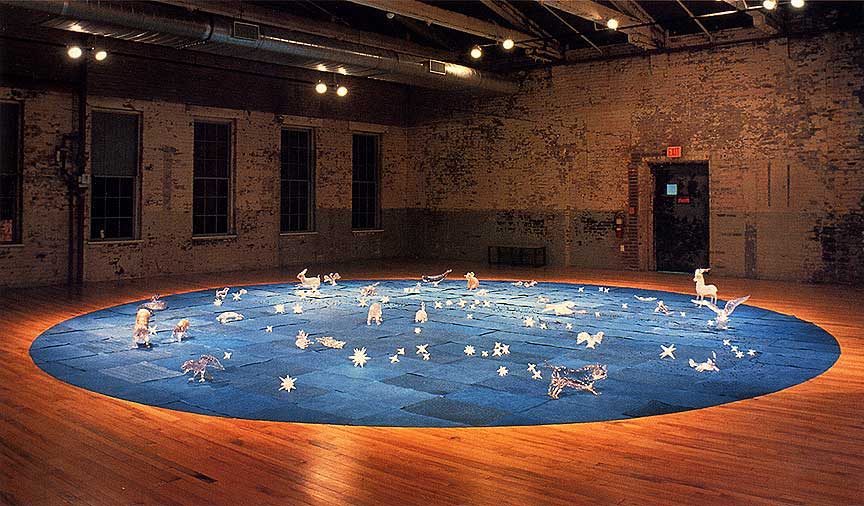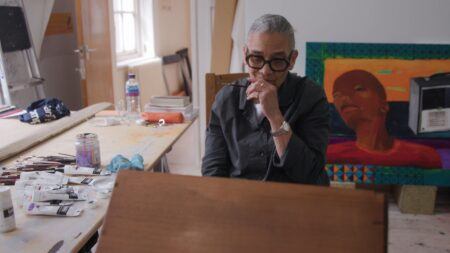Interview
Family History and the History of Objects

Production still from the Art in the Twenty-First Century Season 2 episode, Stories. © Art21, Inc. 2003.
Kiki Smith talks about the roles that her family, domesticity, and death play in her work.
ART21: What is it that you like about domestic objects?
SMITH: [All the things] we use in our daily lives are these forms that have these deep, long histories to them. Those are special things to pay attention to. It’s important to pay attention. Like I was saying when we were talking about beauty—I think you are supposed to have a beautiful environment in your private life. But sometimes, in art, maybe it is like Richard Tuttle was saying—that it’s important to make things ugly, also. It’s always about shifting the possibilities of what can be beautiful.
One’s self is always shifting in relationship to beauty, and you always have to be able to incorporate yourself or your new self into life. Like, your skin starts hanging off your arms and stuff, and then you have to think, “Well, that’s really beautiful, too. It just isn’t beautiful in a way that I knew it was beautiful before.”
You always have to be shifting what your idea of beauty is to make your life wonderful. I think, in your private life, you’re supposed to make it like a paradise garden, like Islamic paradise gardens, where you’re to make heaven on earth. Earth is to be a representation of our vision of heaven. That’s why you’re supposed to be attentive to your environment in your private life, and then in the social realm and in nature and everything. Your private life is a place where you have some possibilities that are not determined by economics, but just determined by paying attention, by being attentive.

Kiki Smith. Constellation, detail, 1996. 26 various glass animal units, 630 bronze scat units, and 67 glass star units; installation dimensions variable. Photo by Ellen Page Wilson. Courtesy of Pace Gallery, New York.
I use my house as a studio, so, you know, most of the time it’s just a wreck. It’s like a domestic house that then has a studio on top of it. And you know, I don’t really care. And I’m really lucky to have a housekeeper; it knocks the damage back a little bit. But in my fantasy life, everything is very clean and orderly, in order for it to be beautiful.
The most important thing for me is looking at objects. Looking at things that people have made. I’m sort of a private person, and my life isn’t so much about my social relationships to people. It’s more about looking at what people have made—appreciating people through what they have made, or what they do, or something like that—rather than having too much interaction with people. So, I need to go look at things all the time—having things is just about looking at them—and then I don’t have to be so attached to them for endless quantities of time. Maybe you see something once, and then it resonates in your mind for long periods of time afterwards, for years sometimes.
My suffering is that I see that there are these really great forms. They’re holy in a way, like they have this really incredible power about them. And all I can do is recognize it. My ego wants to be able to make one also. I want to be able to make something in that tradition. But it’s really difficult; it’s totally different.
Designing—that’s an absolutely different way of working. To will something or to want something into the world rather than just, you know, the listening version. It has to be a collaboration between listening and your own interest and access to making something. You have to have all those things in place.
ART21: So, printmaking is one area where you listen but you also make.
SMITH: Well, you have to. It’s like a physical devotion or dedication. You have to just be stubborn and persevere until you get it right. That’s why I like printmaking or working in sculpture. It’s a generous way of working, in the sense that you can go forwards and backwards. You can make a mark or, like with drawing, you can make a mark and then you can erase it. And then you can make it again, and erase it, and make it, and erase it. You can do it fifty billion times ’til you get it some way.
I just made a print now, and it’s the first time I drew, like, a real person in a print. And it was because I had been drawing these dead animals, and then I thought, “Well, I can move up the chain and draw a person.” And it was really difficult. My assistant said, “Oh, it looks really great” in the beginning, and I was saying that maybe what I was ending up with didn’t have as much art in it or something. I want that pleasure of struggle. That’s the really the fun part of just being left alone.
Lots of times, I watch television. I don’t watch it so much as I listen to it. It’s like a meditation. It’s just clears my brain, and I stop thinking about whatever I’m thinking about, and then I’m just free and I sit and work. It’s also because lots of the work that I’m doing is just labor. One second, you have an idea to make things. And then you have to actually do them, and that takes hours and hours of time to do it. A lot of it’s just, like, scratching on things or smoothening it; it’s not that interesting. A lot of it is just labor. But the labor part, to me, makes me feel free. I enjoy that the most.

Kiki Smith. Constellation, 1996. Glass, bronze, and blue Nepal paper; installation dimensions variable. Installation view at MASS MoCA, North Adams, Massachusetts. Courtesy of MASS MoCA.
ART21: That reminds me of a picture of you and your sisters, sitting around a table, making models for your father’s sculptures.
SMITH: I definitely didn’t have the same love when I was a child, doing labor for my father. But I realize how much I got from it afterwards. He would give us these lectures. We’d be, like, six or seven years old, and you’d make the slightest mistake of asking a question about how something worked, and then you’d get a five-hour lecture about how to use a slide rule. Maybe for about two or three days, you could remember how to use a slide rule. And after that, it just went right out . . .
It was obviously things that he was thinking about and that he was interested in, like maps. I remember there was a certain point where someone had invented how to make a map with three colors, and so we’d do that. Or he would [have] us paint words on wood and put them all over the house. We’d do all these things, which at the time I was sort of semi-half-involved with and then also trying to get out of it.
When I think of my childhood, it was all spent helping my father. We’d do yard work, and then we’d help him with his sculpture. Other kids would go out to day camp or whatever people did, and we’d be there dividing twigs. He’d make us divide twigs into different sizes of twigs—you know, just endless, endless, endless, endless things. He’d save all the boxes, or he’d save all the newspapers and stuff.
At the time, I was always the one who tried to get out of it the most. But at the same time, I see how it’s really beneficial to me in my life now. I’m always moving the furniture around, always from one place to another, and I think, “Well, I grew up doing this.” I have this belief that everything has this mobility, this possibility for mobility in it, and that nothing is fixed. Working and the things that I hated the most as a child are what I appreciate the most as an adult now. I see that really formed my personality. It’s funny.
We were a little bit like The Addams Family. We lived in this big house, and there was a gravestone with our name in front of the house. We had this enormous sculpture in the back of the house. And we were really unpopular, and the kids would say I was a witch. And my father had a beard and a Porsche, and we were really mortified—embarrassed, you know, that he had a car like that and didn’t have a big, woody station wagon. He had a beard, and we would beg my mother to have him drop us off a block before school, so we wouldn’t be seen with a father with a beard. And then, in the sixties, all of a sudden it was really cool and popular. All the boys liked to be around us because my father had a beard and was an artist. So then, it worked to my advantage, all of it. But before that, it wasn’t so much fun always being the weirdos. But you know, I am the weirdo now. I grew up in a kind of morbid household, and now I’m a morbid adult, and it suits me just fine.

Kiki Smith. Wearing the Skin, 2001. Ink and pencil on paper; 72 1/4 × 88 inches. Photo by Kerry Ryan McFate. Courtesy of Pace Gallery, New York.
ART21: Whose gravestone was it in front of your house?
SMITH: I think one of my father’s brothers nipped it from a graveyard. It just said “Smith” on it. In fact, one whole part of our house was all my father’s parents’ clothing, all from the late 1800s. He was born in 1912, so it was all this beautiful Victorian stuff—and teeth, people’s dentures. His parents died within a short time, when he was young. And I think one aunt came and took all the furniture away and all the things that nobody wanted, like letters and things that were just put in the attic. We’d go in there, and it was this whole room full of things from the turn of the century. Shortly after, maybe up ’til the ’20s or ’30s, it was all death, death everywhere. I liked it a lot.
ART21: Is that where some of this storytelling comes from, in your work?
SMITH: I don’t know; I’m not sure. In my family, there was always a kind of morbidity. My father would always say that it’s Irish Catholic to be morbid, or the Irish are morbid people. When I was little, I had lived in a part of the house where no one else lived. It was a wing. My father’s parents made fire hydrants, the prototypical American fire hydrant; it’s all A. P. Smith Manufacturing. And he had about five brothers and one sister, so he built a gymnasium for the boys so that they wouldn’t ruin the house. And then that sister lived above the gym, in this private wing of her own. And so, I lived there.
In the room, I had a skull. My father had a skull of someone—for drawing, you know, for art. And then I put a picture of Charlie Manson (when he was on the cover of Look or Life magazine, one of those) on the skull, and I’d go, “You can’t get me!” Every time I’d walk in the room, I’d always go, “You can’t get me Charlie Manson!” And I must have been pretty old by then. I guess it was 1967 or something like that.
I always think that somebody’s going to get murdered or something like that when the phone rings. I used to be—not so much in this house, in my old house—afraid to come home because I thought somebody would have died. And that building—something always did happen the second I walked in the building. Nobody died, but the fire department would come immediately and say “You have to clean out your hallways in twenty-four hours” or something bad was going to happen.
Now, it’s much less than when I was a kid. It was like I expected death all the time, any second. Everything was going to die and disappear, all the time. Now, it’s less. Now, it’s much less. Now, half my family is dead, so I’m getting used to it. You kind of realize that it’s okay. You know, it’s perfectly okay, people dying. It’s the most normal thing in the world. But as a kid, I didn’t really like it.
My work now is much, much less preoccupied with death than it was. When I first started making things about the body, for probably the first five years or so, it was all about death. My father died, so I was trying to think about why it was okay, being dead. When people are dying, I have to always remember that I’m not dying. I’ll see that you can sort of start taking on, not the same symptoms of it, but you act as if you’re leaving, too. But you’re not leaving; you’re perfectly fine. Everything’s perfectly fine. I think you don’t want to separate from them.
I’m much less that way, now; I get to have other interests. For me, when I first made work, it was much more about survival. I really had to protect myself and to survive, maybe to survive myself and protect myself to survive myself. When I was about forty, then I started being able to make work about what was interesting to me. And then my work became much weirder and personally egocentric. I always think I never would have an art career if I had started now. But I’ve got to have a much wider world other than just surviving. I would say I still have a very deep necessity in my work, and a deep necessity for self-expression, and then a deep necessity to make this mediated stuff in between me and the world. But it’s much freer now.
I think art is like that: making things to protect yourself. I always say my art’s like my army in the world. That’s how you make a lot of it. You store it up and hoard it and get it like your army—strong—to protect you. It’s this thing that you put out in the world that’s the most exposing thing that you can show about yourself. It’s the most exposed you can be, but it’s mediated. It’s like a doll that is a space between you and the world. You’re very protected because you can always go, “Oh, that’s the work.”
Lots of times, like when I was younger, I would talk about my work, and I’d talk about very personally why I made it—because it comes just out of ordinary, everyday life interests, or something like that. But if someone would call you on it, it was if they knew you. And I would always go, “Oh, no, that’s different!” You can’t make an assumption of knowing me privately. I retain and hold my privacy to myself. I like that—that you can have this very exposed version in public. It’s a little bit like having a transitional object or something that functions in an intermediary space.

Kiki Smith. Born, 2002. Bronze; 39 × 101 × 24 inches. Edition of 3. Photo by Kerry Ryan McFate. Courtesy of Pace Gallery, New York.
ART21: Do you think morbidity and the more personal pieces you are doing now are like two different strands running through your work?
SMITH: No, I wouldn’t. In terms of strands, I would say that basically I’m just a curious person, and I’m trying to get an education in my slow way. I practically flunked out of school. I went to an unaccredited high school. I went to a trade school for baking afterwards, because I had this idea I was going to be an Irish washerwoman otherwise, and I better figure out something. And so, I went to trade school for baking, and then I thought that wasn’t really that much fun because it was just industrial baking.
Basically, I think art has all these other elements, but it’s just a way to have the opportunity to think about things. I don’t have a place I’m trying to make it go. I’m not trying to control it at all. Sometimes it’s more interesting to other people, and sometimes it’s not. It’s like standing in the wind and letting it pull you whatever direction it wants to go. Some stuff is really direct. Things start telling you what you’re supposed to pay attention to. It really just comes in you and tells you, “Pay attention to this” and “Make this.” I have lots of times where my work just said, “Make it like this.” And then, it’s like you’re a faithful servant: I make this meditation or give myself to this work.
Interviewer: Susan Sollins. Originally published on PBS.org in September 2003; republished on Art21.org in November 2011.



